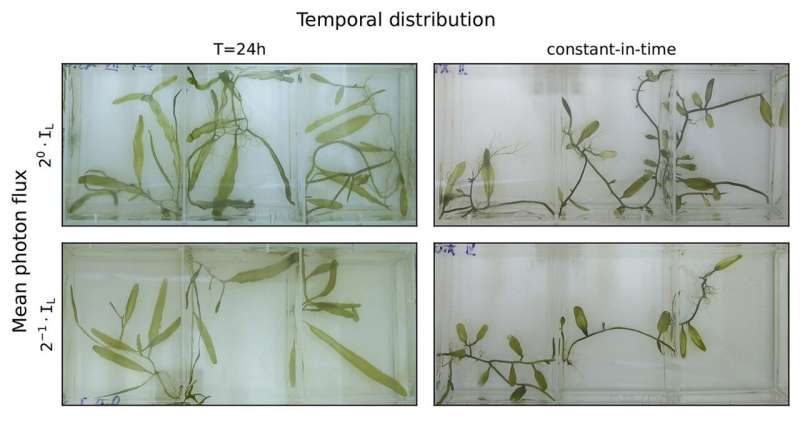This article has been reviewed according to Science X's editorial process and policies. Editors have highlighted the following attributes while ensuring the content's credibility:
fact-checked
peer-reviewed publication
trusted source
proofread
How the growth of a giant single cell is intertwined with daily self-rhythms

Caulerpa is a type of marine algae made up of one extended cell, though each plant can grow to be a meter across. While there are many individual nuclei within a Caulerpa plant, it contains no cell membranes that would normally divide the plant into many individual cells, resulting in a free-floating environment of cytoplasmic goo. As a result, Caulerpa poses interesting questions for developmental biologists—how does it carry out the normal functions of plants without being made up of separate cells?
Most plants grow because each of their living cells takes on specific tasks, such as sprouting into a leaf or stem. Many multicellular organisms undergo this process of differentiation; for example, specialized human organs like the heart and brain develop from a blob of embryonic cells. Researchers theorize that a key to differentiation is the ability of cells to communicate with others around them, coordinating their activity to enable the embryo to "break symmetry" and develop into different parts.
But how then does a single-celled plant like Caulerpa grow without specialized cells communicating to guide the breaking of symmetry?
"A main paradigm in cellular biology is that the internal environment of a cell is dictated by its environment and what happens in the nucleus. But in Caulerpa, there's nothing to separate the nuclei one from another," says Caltech postdoctoral scholar Eldad Afik.
"How does Caulerpa create the differentiated environments that we are familiar with as organs in multicellular plants? Our hypothesis is that the plant sends out waves of chloroplasts synchronized with the day and night light cycle."
Led by Afik, a new study from the laboratory of Elliot Meyerowitz, George W. Beadle Professor of Biology and Howard Hughes Medical Institute Investigator, shows that Caulerpa maintains a kind of internal clock guided by the day-to-night cycle of light.
The study suggests that light can stimulate Caulerpa to emit waves of chloroplasts throughout its body, conducting photosynthesis to produce energy and grow. Caulerpa can adjust itself to different lengths of day and night—12 hours of day and 12 of night, or some other variation—though researchers are still uncertain about the molecular mechanisms that underlie this process.
The study, titled "Macroscopic waves, biological clocks and morphogenesis driven by light in a giant unicellular green alga," is published in the journal Nature Communications.
The researchers theorize that the chloroplasts conduct photosynthesis when there is light, converting photons into energy for the plant. When there is no light, the plant undergoes respiration—when energy stored during photosynthesis is consumed by the plant. These two separate states, according to the researchers, could create two distinct environments that act as symmetry breakers.
The team found that different light conditions would produce different morphology (how the plant looks). Caulerpa plants grown under a cycle of 12 hours of bright light and 12 hours of dark show fewer and longer leaves than those grown under 24 hours of constant comparable light. The cycling between day and night seems to be important to signal to the plants when it is time to grow and when it is time to "rest."
"In future work, we aim to look at how the waves of chloroplasts are linked with metabolism and the synchronization among the different parts of the plant and the different shapes that they end up in," Afik says.
More information: Eldad Afik et al, Macroscopic waves, biological clocks and morphogenesis driven by light in a giant unicellular green alga, Nature Communications (2023). DOI: 10.1038/s41467-023-41813-6
Journal information: Nature Communications
Provided by California Institute of Technology




















